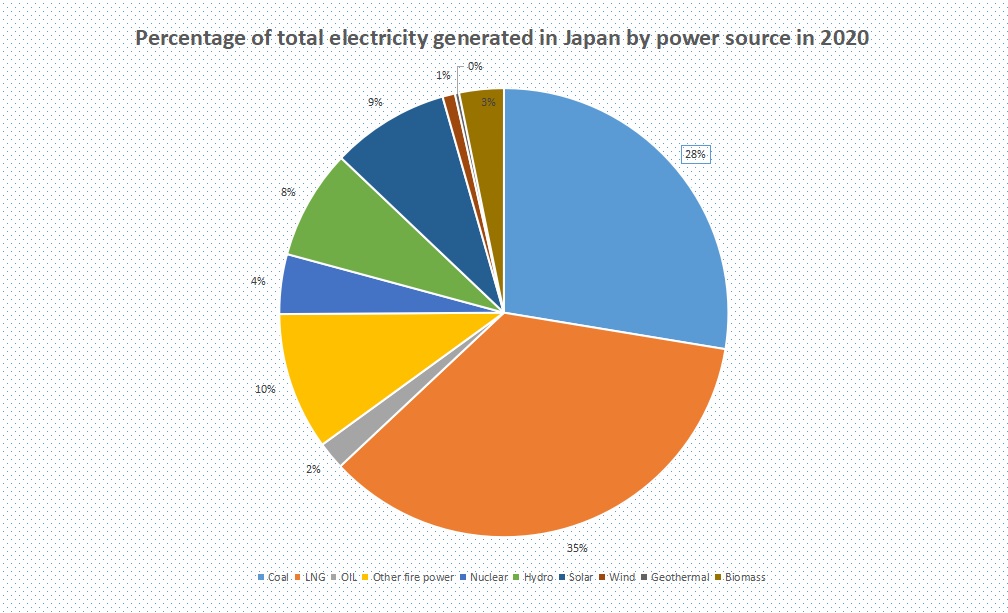Percentage of total electricity generated in Japan by power source
The Ministry of Economy, Trade and Industry (METI) announced on July 21 the draft of the new basic energy plan. The plan is to increase the ratio of renewable energy to the total amount of electricity generated in FY2030. The ratio of renewable energy The ratio of renewable energy will be increased to 36-38%, and The ratio of nuclear power will be maintained at 20-22%. Coal-fired power will still account for 19%. As coal-fired power still accounts for 19% of power generation, the amount of greenhouse gas emissions per unit of power generation will be emissions per unit of power generation is still high compared to Western European countries.
This draft of the basic plan for 2030. Many experts in this field think it is a very poor draft.

Japan has made an international pledge to reduce its carbon dioxide emissions by 46% by 2035 compared to 2013. However, it is hard to believe that this can be achieved five years after the draft of the 2030 Basic Plan, which is completely inconsistent.
What's more Nuclear power will account for 20-22% of total power generation. It is also unrealistic to expect that nuclear power will account for 20-22% of total power generation. Even if we operate the remaining reactors at full capacity I doubt if we can reach this level even if we operate the remaining reactors at full capacity.
The operation period of nuclear reactors is set at 40 years, and by 2030, the amount of electricity generated will be about half of the current level. I think it will be difficult to generate 36-38% of the total amount of electricity from renewable energy.
In the case of Japan, it would be impossible to increase the amount of power generation all at once, because we can't take the style of Denmark, where household garbage is burned and used as renewable energy.

Furthermore, Japan's oceans are not suitable for wind power generation because of their sudden depth, and to achieve the goal of solar power generation, we would have to cover the whole country with solar panels.
The barrier to geothermal power is the ridiculous 10-year approval process.
In light of the current situation, the draft of the basic plan is not at all convincing. Looking at the trends in the composition of power generation by power source in Japan (see the chart), the percentage of nuclear power has been close to zero since the Fukushima Daiichi nuclear accident, with coal, oil, and LNG providing the rest. The share of hydropower has remained constant, and the share of new energy has increased slightly, but it is still a small percentage.
I have to say that it will be difficult to reduce carbon dioxide emissions by 46% by 2035 compared to fiscal 2013, or even to have renewable energy account for 36-38% of total power generation, as set forth in the current draft of the Basic Plan.
Scandinavian countries have been dealing with environmental issues for a long time, and the foundation for generating power from renewable energy sources is completely different from that of Japan. For example, in Denmark, renewable energy (electricity produced from solar and wind power) will account for more than 50% of electricity consumption in 2020. They also collect urban waste and other waste materials and generate bioenergy from them.
Even in Germany, which is lagging behind the efforts of Scandinavian countries, a system has been set up to encourage farmers to install windmills to generate their own power and to incorporate the surplus energy into the network. When this is not possible, the country has adopted a policy of converting the energy into hydrogen and storing it, and is taking concrete steps to utilize renewable energy.
There is a big difference between European countries and Japan in terms of their approach to environmental issues and use of renewable energy. I feel that it is the determination of politicians that makes the difference.



One thought on “Percentage of total electricity generated in Japan by power source”